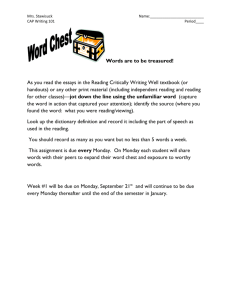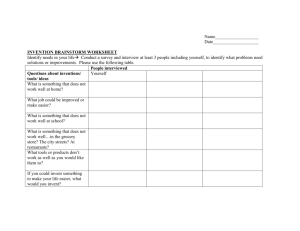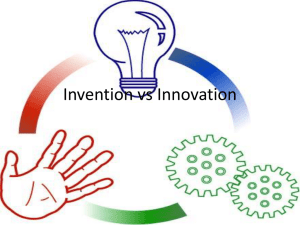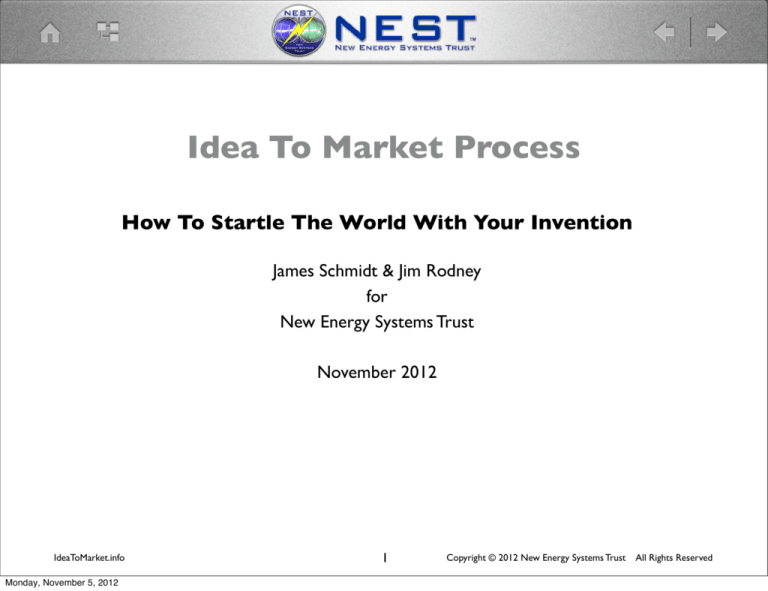
Idea To Market Process
How To Startle The World With Your Invention
James Schmidt & Jim Rodney
for
New Energy Systems Trust
November 2012
IdeaToMarket.info
Monday, November 5, 2012
1
Copyright © 2012 New Energy Systems Trust
All Rights Reserved
Idea To Market Process
How to use this document
This document contains linked navigation. Click on the boxes in the flowchart on page 5 to jump to the respective subject pages.
You can also navigate using icons on the top:
Home - takes you back to Home page
Flowchart - jumps back to the flowchart from any page.
Forward | Back arrows - next or previous pages
Underlined text is hyperlinked directly to web pages.
Legend: the three different colors represent Financial, Engineering & Business categories.
Financial
Engineering
Business
This document is available for download for free, but we ask for a donation of $5.00, or more if you wish to support the work of
the New Energy Systems Trust. A link for donating can be found at: http://IdeaToMarket.info
IdeaToMarket.info
Monday, November 5, 2012
2
Copyright © 2012 New Energy Systems Trust
All Rights Reserved
Steps in the Process
Introduction ...............................................................
Idea ..............................................................................
Documentation ..........................................................
Seed Funding ..............................................................
Experimentation and Analysis ................................
Lab Prototype ............................................................
Design Refinement ....................................................
Validation Testing ......................................................
Market Assessment ..................................................
Invention Protection Strategy ................................
Stage I Investment ....................................................
Engineering & Development ....................................
Engineering Optimization ........................................
Business Strategy ......................................................
Business Plan ..............................................................
Market Validation ......................................................
Stage II Investment ...................................................
Production Prototype Engineering .........................
Production Model Testing ........................................
Market Launch ...........................................................
Next Steps ..................................................................
Summary .....................................................................
NEST to the Rescue ..................................................
Resources ....................................................................
IdeaToMarket.info
Monday, November 5, 2012
3
4
6
7
8
9
10
11
12
13
14 &15
16
17
18
19
20
21
22
23
24
25
26
27
28
29
Copyright © 2012 New Energy Systems Trust
All Rights Reserved
Introduction
"You might have the best technology in the world, but if you don't get it to market, it's useless."
Shaun McCarthy
This presentation is intended to give the inventor or entrepreneur an overview of the steps and processes involved in taking an invention from
idea to finished product in the market place.
The process begins with demonstrating that your idea or concept works (proof of concept). Next is a laboratory prototype that might be the
forerunner of a manufacturing model. The lab prototype validates your idea/concept and even allows third parties to test your design.
Along the way it is a good idea to thoroughly document your idea, the design and the test results. This is particularly important for
copyrighting or patents.
Once you have validated your idea and demonstrated the device, you may consider getting it manufactured or selling the rights to your device. This is where you may want to protect your invention either through the patent process, by copyrighting or deciding to open-source it. Each
of these paths has its own process and pitfalls. It is important to get business guidance help at this point.
Most inventors do not have the financial resources to get all the way to the market. Your documentation and validation testing will help you
secure early funding for your idea. In most cases investors will want some level of control over your project to ensure their returns. Selling
your idea to an investor or manufacturer requires not only undeniable test data and convincing demonstrations, but also a great presentation
by you or a credible third party. There are many incubators across the country that can help you with this.
NEST is dedicated to helping inventors and entrepreneurs bring their exotic technologies to the market. NEST’s mission is to assist the
inventor with advice, engineering, prototyping services and validation testing. In addition, our NEST team can assist in soliciting such funding on
behalf of the inventor.
Feel free to contact us with your needs - we’re here to help. Good fortune with your next exotic technology invention!
The NEST Staff
IdeaToMarket.info
Monday, November 5, 2012
4
Copyright © 2012 New Energy Systems Trust
All Rights Reserved
Idea to Market Flow Chart
Idea
Market
Assessment
Invention
Protection
Strategy
Stage II
Investment
Production
Prototype
Engineering
IdeaToMarket.info
Monday, November 5, 2012
Copyright
Open Source
Market
Validation
Lab
Prototype
Design
Refinement
Validation
Testing
Patent
Experimentation
& Analysis
Seed
Funding
Documentation
Stage I
Investment
Engineering
Optimization
Engineering &
Development
Create LLC
Business
Plan
Production
Model
Testing
Incorporate
License
Manufacturing
& Distribution
5
Business
Strategy
Market
Launch
Copyright © 2012 New Energy Systems Trust
Next
Steps
All Rights Reserved
Idea
You have an original idea
or
You have an idea for expanding on an existing invention.
Do you have the means to explore the idea with
•
•
Performing experiments
Building prototypes
or do you need to solicit some help?
IdeaToMarket.info
Monday, November 5, 2012
6
Copyright © 2012 New Energy Systems Trust
All Rights Reserved
Documentation
Begin to document your idea.
•
•
•
Have your documents dated and witnessed.
•
Keep your journal in a safe place.
Get a good journal and keep detailed notes in it.
It is also a good place to document your analysis, any changes you
make as well as results of experiments.
This documentation will be important for the patent process and for
providing data for potential investors and licensees.
IdeaToMarket.info
Monday, November 5, 2012
7
Copyright © 2012 New Energy Systems Trust
All Rights Reserved
Seed Funding
Solid financing is essential for getting a great idea off the ground.
However, investors tend to shy away from ideas that are still on paper.
You will have to fund the initial research and development yourself.
This “seed funding” can come from several sources:
•
•
•
•
•
Savings
Second mortgage on the house
Family members
Friends
Crowd funding
A solid plan with some demos could help convince others to support your idea.
They should clearly understand that they could lose their money.
IdeaToMarket.info
Monday, November 5, 2012
8
Copyright © 2012 New Energy Systems Trust
All Rights Reserved
Experimentation & Analysis
An idea is only the start.
You must show and provide evidence that your idea will work in the real world. *
Define in engineering terms what your device is intended to do, including the
subcomponents or subsystems needed to make it operational.
•
What size, operating parameters, inputs etc.
Begin by experimenting with each subcomponent of your device.
Integrate the experiments.
Take care to document the results of each aspect of the experimentation.
* Be sure that any disclosures of the technology are done under Non Disclosure Agreement (NDA) or at least 'CONFIDENTIAL'
terms, otherwise you could jeopardize your technology, including the option of patenting the device. Technologies in the public
domain cannot be patented.
IdeaToMarket.info
Monday, November 5, 2012
9
Copyright © 2012 New Energy Systems Trust
All Rights Reserved
Lab Prototype
Build a prototype of your invention.
Keep it small so that changes are easy to make.
Think it through before you build. Nikola Tesla would complete his devices in
his head, working them through in his mind before building them.
Document, document, document.
IdeaToMarket.info
Monday, November 5, 2012
10
Copyright © 2012 New Energy Systems Trust
All Rights Reserved
Design Refinement
Often, an initial design based on experimentation does not meet expectations.
Refine the design.
Do more experimentation to find solutions that enhance your model.
Refine the design.
Once you have something working you can begin soliciting help for promotion and
long-term funding. *
You can and should always be improving the design; but at some point you need to
settle on a version that is far enough along to make a good demonstration.
Then it is time to convince others of the value of your invention.
You can improve on it later with financing.
* Be sure that any disclosures of the technology are done under Non Disclosure Agreement (NDA) or at least 'CONFIDENTIAL'
terms, otherwise you could jeopardize your technology, including the option of patenting the device. Technologies in the public
domain cannot be patented.
IdeaToMarket.info
Monday, November 5, 2012
11
Copyright © 2012 New Energy Systems Trust
All Rights Reserved
Validation Testing
You will want to do third party validation testing of your device/product to convince
investors to take you to the next step. *
If possible, get two or three third-parties to validate the operation of your device.
Third-parties will want to measure and compare the input and output in addition to early
testing of other factors like efficiency, cost savings, emissions, safety, pollution, etc.
Third-party testing is invaluable to your credibility and to the salability of your device.
“Third-parties” refers to qualified parties, such as universities or laboratories, that are not
tied to the project.
Continuing documentation is important.
* Be sure that any disclosures of the technology are done under Non Disclosure Agreement (NDA) or at least 'CONFIDENTIAL'
terms, otherwise you could jeopardize your technology, including the option of patenting the device. Technologies in the public
domain cannot be patented.
IdeaToMarket.info
Monday, November 5, 2012
12
Copyright © 2012 New Energy Systems Trust
All Rights Reserved
Market Assessment
Ask these questions to help determine your probability of business success:
•
•
•
•
•
•
•
•
•
What is the primary function of your invention?
Is this a major improvement over existing methods/devices?
What are the major applications of your invention?
How large are the key markets you are targeting?
How big an impact might your technology have on these markets?
Would this be considered a “disruptive” technology or an incremental improvement?
Does your technology offer major competitive advantages - i.e. 80% less cost?
Does the market exist today, or will you have to develop it?
How difficult do you feel it will be to develop, test, and protect?
IdeaToMarket.info
Monday, November 5, 2012
13
Copyright © 2012 New Energy Systems Trust
All Rights Reserved
Invention Protection Strategy: Patents, Copyrights, IPCB
It is important for the serious inventor to protect his invention from being copied and
commercialized by others, prior to significant public and investor encounters.
There are two basic ways to protect your invention/idea:
• By a patent
• By a copyright
“A patent grants third parties the right to copy the description (text and drawings) of an
invention but forbids them to commercialize it.” www.sosinvention.com
• United States Patent & Trademark Office: www.uspto.gov
“A copyright forbids third parties to copy the description (text and drawings) of an
invention in order to commercialize it.” www.sosinvention.com
The WIPO is a great source of information on Intellectual Property rights.
A subset of the copyright is the intellectual passport CB
• The IPCB may provide better protection than a patent.
• See Sterling Allan’s excellent description and research.
IdeaToMarket.info
Monday, November 5, 2012
14
Copyright © 2012 New Energy Systems Trust
All Rights Reserved
Invention Protection Strategy: Open Source
An alternative to fully protecting your invention from copying and commercialization by
others is to go open-source.
Open source encourages people to replicate, improve, and commercialize the technology
that you have developed.
To be highly successful in the open-source approach, the technology should be:
• Easy to understand
• Easy to build
• Inexpensive
• Have significant power output
• Unencumbered intellectual property
You can always request a royalty for all commercial sales of others, but you will be relying
on the honor system unless you have a patent.
Open-source is a way of getting your invention widely spread and benefitting mankind.
Once it is public, a patent cannot be filed by anyone else.
You can still patent the device before going open-source.
IdeaToMarket.info
Monday, November 5, 2012
15
Copyright © 2012 New Energy Systems Trust
All Rights Reserved
Stage I Investment
Most inventors/entrepreneurs require financial assistance.
After the proof of concept and validation testing you may want to solicit investor funding.
• To use for additional research and development
• To scale up your prototype
• For additional testing or test hardware
There are many sources of financial help.
• Venture capitalists
• Angel investors
• Crowdfunding
• Corporation
• Manufacturers
Develop a plan for presenting your idea to investors.
Get professional help.
Be prepared to demo your device and present relevant data.
Be prepared to get outside help for soliciting investors and negotiating the terms of the
investment.
IdeaToMarket.info
Monday, November 5, 2012
16
Copyright © 2012 New Energy Systems Trust
All Rights Reserved
Engineering & Development
Once you have provided a proof of concept, you are ready to engineer a more robust
prototype. You should build multiple prototypes for redundancy and to illustrate the
technology on different scales or embodiments.
This will require careful consideration of each of the design parameters.
•
•
•
•
What will the working application be? Powering a generator or car?
What are your design goals? Horsepower, torque etc.?
Are there any size constraints?
Other engineering problems to address?
Begin developing prototypes that reflect these design parameters.
Each aspect of your design will have to be researched, built and tested.
Once you have each unit built to reflect your design parameters, you should perform
characterization tests to see if it meets your specifications.
IdeaToMarket.info
Monday, November 5, 2012
17
Copyright © 2012 New Energy Systems Trust
All Rights Reserved
Engineering Optimization
Once your engineering prototype generally meets your expectations, you will want to
optimize the design.
You will want to make it as efficient as possible for the size constraints.
There may be cost considerations in some of the materials used.
You may want to balance some of the engineering parameters.
Some of the tolerances or specifications may be difficult to meet.
This continued development and testing to achieve your engineering goals is referred to
as “engineering optimization”.
IdeaToMarket.info
Monday, November 5, 2012
18
Copyright © 2012 New Energy Systems Trust
All Rights Reserved
Business Strategy
At some point in the process, you will need to decide on a business strategy for the
continued development, manufacturing and sales of your product or invention.
Your business path will depend on many factors.
• Your personality
• Your business abilities
• Your technical abilities
• Your goals and objectives for the invention
You may want to handle everything from beginning to end.
You may want to get other experts and consultants involved.
You have several choices:
• Sell your invention.
• License your invention or product to a manufacturer or other entity.
• Develop an LCC as a business entity to operate under.
• Create a corporation with the intention of manufacturing your own product.
• Open source your invention.
IdeaToMarket.info
Monday, November 5, 2012
19
Copyright © 2012 New Energy Systems Trust
All Rights Reserved
Business Plan
A well-researched and documented business plan is essential to the success of your business.
Writing a business plan forces you to research and plan for every aspect of your business.
A business plan takes into consideration every cost and needed resource.
A good business plan will help you convince the investors to buy in.
A business plan may take several months and thousands of dollars to do properly.
Get help with your business plan.
Ask business experts to review your plan.
IdeaToMarket.info
Monday, November 5, 2012
20
Copyright © 2012 New Energy Systems Trust
All Rights Reserved
Market Validation
You now have a device/product that has been validated according to your expectations
Before you solicit major capital to fund the manufacturing of your device, you will want to
ensure there is a market for your product.
This can be done several ways, depending on the market and your product:
•
Simple focus group panel reviews may be all that is necessary.
•
You can invest in some market research.
•
You can develop a market prototype for early “beta testing”.
•
Advertise on blog sites, industry related magazines, etc.
This can lead to an early level of interest in licensing, partnering or distribution rights, etc.
and increase the probability for manufacturing funds and long-term business success.
IdeaToMarket.info
Monday, November 5, 2012
21
Copyright © 2012 New Energy Systems Trust
All Rights Reserved
Stage II Investment
The manufacturing stage is where investors are ready to make serious commitments.
•
•
You have validated and demonstrated your product and team.
You have established credibility via your demos and validation tests.
Investor commitment will involve considerable negotiations as you give up some or even the
majority of control of your invention.
You will have to decide what involvement you will have going forward.
•
•
•
•
You can sell your invention outright.
You can maintain some control and do your own manufacturing.
You can simply be a consultant after selling your product.
Or you can outsource the manufacturing with continuing involvement.
Develop a great presentation for your invention or product.
•
•
A demonstration by itself will not cut it. You are part of the presentation.
Get help from qualified professionals who have the presentation skills – your future
depends on it.
Postscript: rather than seeking investment, you might consider crowdfunding.
IdeaToMarket.info
Monday, November 5, 2012
22
Copyright © 2012 New Energy Systems Trust
All Rights Reserved
Production Prototype Engineering
Production models are essential for several reasons;
•
Establish the feasibility and ease of production in all phases.
•
Help establish the manufacturing process and controls.
•
Determine accuracy of manufacturing specs.
•
Establish manufacturability of all components.
•
Enable setup of quality control procedures.
The design which emerged from the research and development phase will
serve as the basis for developing a production model.
The production prototype will be used to address each of the areas of
production listed above.
IdeaToMarket.info
Monday, November 5, 2012
23
Copyright © 2012 New Energy Systems Trust
All Rights Reserved
Production Model Testing
Production validation testing (alpha testing) is used to:
•
Ensure production models will meet specifications.
•
•
•
•
Establish the reliability of the production models.
•
Evaluate for possible operational hazards: chemical emissions, radiation,
electromagnetic emissions, etc.
•
•
Submit for certification to UL, CE, etc.
IdeaToMarket.info
Monday, November 5, 2012
Evaluate maintainability and maintenance requirements.
Use to determine quality control processes.
Test for environmental hazards: heat, cold, vibration, altitude, etc.
The production model is then ready for “beta testing” with select
customers in real life situations.
24
Copyright © 2012 New Energy Systems Trust
All Rights Reserved
Manufacturing & Distribution
After you have proven the design, you are ready to hit the copy button.
How many copies you make before introducing the product to market will depend on
your business plan and strategy.
If you are gradually, incrementally rolling it out, you can start with a small production run.
Or your strategy might be to go with a well-established manufacturer in a specific sector
– going straight to the major leagues.
Or, if you are open sourcing, then manufacturing becomes a free-for-all, enabling anyone
anywhere to build as many, as fast, for whatever application and region they want.
Your business plan will also define how you will be distributing the finished products into
the market. This likewise will vary depending on your strategy.
IdeaToMarket.info
Monday, November 5, 2012
25
Copyright © 2012 New Energy Systems Trust
All Rights Reserved
Market Launch
Congratulations!
You have realized the dream of taking your invention from an idea on paper to
finished product ready for the market.
Marketing your device is a whole new endeavor which will require research and
possibly outside resources.
Your road to future returns on your invention has just begun.
IdeaToMarket.info
Monday, November 5, 2012
26
Copyright © 2012 New Energy Systems Trust
All Rights Reserved
Next Steps
Once you reach the marketplace there are still many processes required to achieve long
term marketing success.
•
Continuing R&D to ever-improve the technology
•
Expanding the number of applications, sizes & scaling
•
Expanding the market reach
•
Going International
Marketing and management represent a whole other set of disciplines not covered here.
There will also be the challenge of managing a company and it’s profits for maximum
success.
IdeaToMarket.info
Monday, November 5, 2012
27
Copyright © 2012 New Energy Systems Trust
All Rights Reserved
Summary
The process of bringing an idea to market is a long and arduous path.
Each step requires diligence and good planning.
You may want to stick to inventing and let your invention be developed and
marketed by the pros.
You may want to keep control all along the way but you may need hire experts
in certain areas to help you succeed.
Whichever route you take, persevere and do not give up!
IdeaToMarket.info
Monday, November 5, 2012
28
Copyright © 2012 New Energy Systems Trust
All Rights Reserved
NEST to the Rescue
NEST can help with the challenges of bringing your invention to the market, including:
•
Assistance in areas where you lack knowledge
•
Expert evaluations
•
Outside lab testing
•
Building prototypes
•
Advice on patents, copyrighting and open sourcing
•
Licensing
•
Financing
The mission of NEST is to assist the inventor or entrepreneur in successfully bringing
his exotic energy ideas and inventions to market.
IdeaToMarket.info
Monday, November 5, 2012
29
Copyright © 2012 New Energy Systems Trust
All Rights Reserved
Resources
Websites/Articles
Bringing your Invention to Fruition - http://voices.yahoo.com/how-bring-invention-fruition-226287.html
Product to Market in Six Steps - http://www.entrepreneur.com/article/201526
How to Bring Your Invention to Market (Inc. Magazine) - http://www.inc.com/guides/solo_business/invention-to-market.html
Ask The Inventors - http://www.asktheinventors.com/
Invention Help - http://www.invention-help.com/invention-help-books.htm
Tools - http://peswiki.com/energy/Tools
Books
“Inventing on a Shoestring Budget” by Barbara Russell Pitts, Mary Russell Sarao
“Bringing Your Product To Market” by Don Debelak
Government Resources
Starting a Business - www.sba.gov/
Business Loans - http://www.sbir.gov/ (Up to $1 Million per award)
U.S. Patent Office - www.uspto.gov/
Coaching:
Professional Coach, Linda Plano - http://www.planoandsimple.com/ (YouTube Series, Boot Camp)
IdeaToMarket.info
Monday, November 5, 2012
30
Copyright © 2012 New Energy Systems Trust
All Rights Reserved
Contact Us
NEST Site Contact Page: http://www.energynest.org/wcontact.php For specific questions or requests for
help with your invention, send a note
to one of the addresses listed below.
For comments or suggestions on the
"Idea to Market” process, send a note to
James Schmidt:
technologies@EnergyNEST.org
James Schmidt: jschmidt@peakpeak.com
Office: (970) 484-9731
Skype: jschmidt113
investors@EnergyNEST.org
professional.services@EnergyNEST.org
customers@EnergyNEST.org
licensees@EnergyNEST.org
volunteers@EnergyNEST.org
jobs@EnergyNEST.org
IdeaToMarket.info
Monday, November 5, 2012
31
Copyright © 2012 New Energy Systems Trust
All Rights Reserved

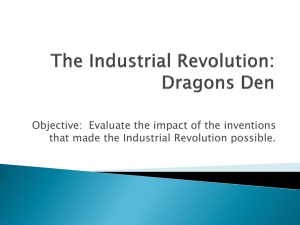
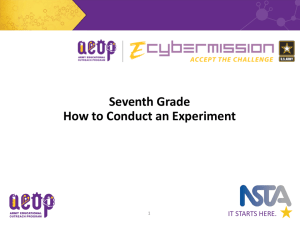
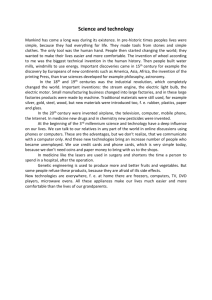
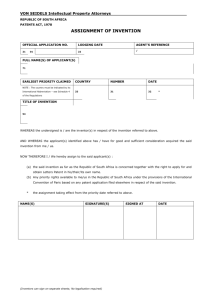
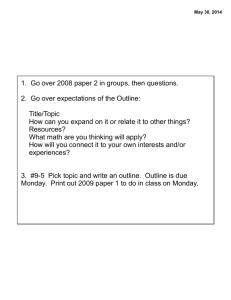
![Introduction [max 1 pg]](http://s3.studylib.net/store/data/007168054_1-d63441680c3a2b0b41ae7f89ed2aefb8-300x300.png)
